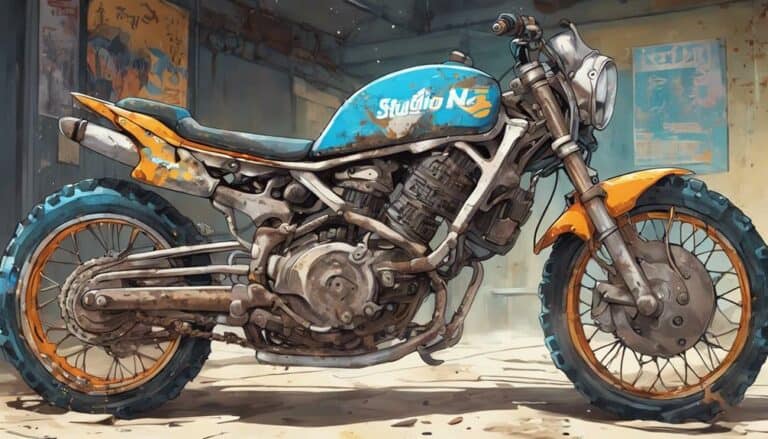When your dirt bike chain starts showing signs of wear, it's like a silent alarm signaling that a closer look is necessary.
But how do you know when it's truly time to replace it? Paying attention to the subtle cues can make all the difference between a smooth ride and potential issues down the road.
Let's explore the key indicators that might be telling you it's time for a new chain and the factors that play a role in this decision-making process.
Key Takeaways
- Regular inspections for wear signs like flex and noise are crucial.
- Timely replacement every 25-30 hours in SoCal ensures peak performance.
- DIY checks can help, but professional assessment guarantees accuracy.
- Consider sealed chains and proper maintenance for extended lifespan.
Signs of Chain Wear
When evaluating the condition of a dirt bike chain, look for signs of wear such as excessive side-to-side flex and loose rollers in the pins. These signs indicate that the chain may be worn out and no longer fitting snugly on the sprockets, especially the rear sprocket.
Inspecting the chain for wear, elongation, and misalignment is important in determining its condition. If the chain shows visible signs of rust or corrosion, prompt replacement is necessary to prevent further damage to the bike. Additionally, unusual noises like grinding or clunking while riding can also indicate a need for chain replacement.
Regularly checking chain tension and ensuring that the links are in good condition is essential for the overall performance and longevity of your dirt bike. By being proactive in inspecting your chain for signs of wear and promptly replacing it when necessary, you can maintain a smooth and safe riding experience.
Importance of Regular Inspections
To maintain peak performance and prevent potential damage to your dirt bike, consistently inspecting the chain for wear and proper alignment is imperative. Regular inspections are key to ensuring your chain is in peak condition.
When you inspect the chains, pay close attention to signs of chain wear such as back and forth movement between chain links, which indicates chain stretch. Visually inspect the space between the rear sprocket and chain; a tight fit signals the need for replacing the chain. Additionally, side to side movement, especially without chain wax applied, can indicate excessive wear. Check for this by twisting the chain to assess its condition thoroughly.
Factors Affecting Chain Lifespan
Proper tensioning and alignment of the dirt bike chain directly impact its longevity and performance. When these factors aren't in good condition, chains are more prone to excessive wear and may require replacing sooner.
Factors affecting chain lifespan include:
- Sprockets: Worn sprockets can accelerate chain wear, so regularly inspect both the chain and rear sprocket for signs of wear.
- Riding Conditions: Riding in dirty or sandy terrains can introduce grit into the chain, causing it to wear faster. Keep the chain clean and well-lubricated to prolong its lifespan.
- Regular Maintenance: Make sure the chain tension is correct, and the alignment is proper. Regularly apply chain lube and inspect for any signs of wear or damage. Proper maintenance can greatly extend the life of your dirt bike chain.
Mileage and Hour Guidelines
For top performance and safety, adhere to mileage and hour guidelines when considering the replacement of your dirt bike chain. The life of your chain can vary depending on factors such as riding conditions and maintenance practices.
In Southern California, it's recommended to replace your chain every 25-30 hours of riding to guarantee peak performance. Keep an eye on signs of wear like excessive side-to-side flex or loose rollers in the pins, indicating that your chain may be reaching the end of its life. Some riders opt to change their chains every 3 adjustments to maintain peak performance.
Additionally, inspect your sprocket teeth regularly, as they can impact the lifespan of your chain. If your chain is old and worn, consult your service manual for guidance on replacing it. Remember to check the master link and consider switching to a sealed chain for improved durability.
Professional Assessment Vs DIY Detection
Consider utilizing professional assessment tools like chain wear indicators for accurate measurements when evaluating the need for chain replacement. When deciding between professional assessment and DIY detection, keep in mind that experienced mechanics can provide precise evaluations.
However, if you prefer to assess the chain yourself, look out for signs of wear such as excessive chain stretch, side-to-side movement, and misalignment. To effectively perform a DIY inspection, conduct visual inspections, measure chain elongation, and refer to manufacturer guidelines for recommended replacement intervals.
Conclusion
As the chain on your dirt bike weathers the terrain, it silently tells a tale of your ride. Listen closely to its whispers of wear and tear, for they speak volumes about your machine's health and safety.
When the time comes to replace it, heed the call for a new chapter in your off-road adventures. Stay vigilant, stay informed, and enjoy the smooth ride ahead.

